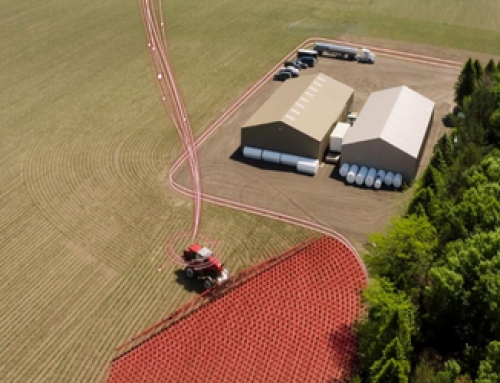Source: CoBank news release
DENVER –A modest rebound in U.S. wheat production and supplies is improving the outlook for profitability among grain elevators that store wheat. Futures market carries have improved for all three major classes of wheat and the buy basis is widening following a bigger harvest. The larger harvest follows two years of poor production and a historic run of inverted futures markets that sapped profitability for storing wheat.
According to a new report from CoBank’s Knowledge Exchange, the major risk to elevators in the year ahead is a sharp rally in wheat prices. Wheat stocks among major exporters are historically tight, and any disruption to the flow of Russian exports through the Black Sea could trigger a sharp price run-up.
“The flood of cheap Russian wheat into the global market may have created a false sense of security in the world wheat market,” said Tanner Ehmke, grains and oilseeds economist for CoBank. “The greatest margin risk to storing wheat is the shrinking world wheat crop outside of Russia and China, which leaves the market vulnerable to supply shocks and extreme volatility in wheat prices.”
The cost of storing grains, including wheat, remains historically high due to the sharp rise in interest rates. As a result, elevators will still struggle to pencil in profit on the wider carries, particularly for the hard wheats. Elevators struggling to make margin on carries will be looking for opportunities to benefit from rising basis on company-owned grain through the marketing year.
U.S. Wheat Harvest
The rebound in the U.S. wheat harvest was largely driven by a substantial increase in soft red winter wheat yields in the Midwest, where farmers produced the biggest crop in nine years. This year’s soft red winter wheat harvest rose 31% year-over-year, based on USDA’s latest estimates.
With ample supply, elevators will benefit from exceptionally wide carries in the futures market and the variable storage rate that adds about 3 cents per bushel to the futures spread. Soft red winter wheat is a low-protein wheat typically used for snack food products like crackers and pastries.
In the Central and Southern Plains, production of hard red winter wheat lost significant yield under ongoing drought. Overall production rose 10% year-over-year, according to USDA estimates, with gains attributable to expanded acreage. The abundance of protein in the hard red winter wheat crop in recent years has resulted in protein premiums falling. Hard red winter wheat is typically used for bread, buns and rolls.
The hard red spring harvest in the Northern Plains is expected to fall 7% year-over-year despite expanded acreage, according to USDA. Late planting followed by persistent drought limited yields. The smaller harvest is compounded by a drop in Canadian hard red spring wheat production that is expected to hold prices at a significant premium in the year ahead. Hard red spring wheat is a high-protein wheat used for products like bagels and pizza crust.
Blending this year’s wheat crop will be a tightrope for elevators, millers and bakers that are challenged to find low- to medium- protein hard wheat in a market saturated with high protein. With the hard wheats trading at a sizable premium, millers and bakers will be motivated to blend more soft red wheat with hard wheat. However, blending will be limited due to stark differences in mixing and baking performance.
World Wheat Supplies
The flood of cheap Russian wheat into the global market, combined with a strong U.S. dollar continue to be major headwinds for U.S. wheat exports. Russia’s currency has fallen sharply, down 30% year-to-date, putting Russian exports on sale and pushing down world wheat prices. Russia is currently harvesting a near-record wheat crop with substantial carryover inventories from last year’s record-sized harvest.
In China, wet weather during harvest damaged a substantial portion of the Chinese wheat crop, which likely result in China increasing wheat imports.
Excluding Russia and China, the world’s wheat stocks-to-use ratio is nearly the tightest on record. Drought has substantially reduced wheat supply in Argentina, Canada and Australia. Ukraine’s wheat harvest faces numerous obstacles to being delivered to the world market due to the ongoing Russia-Ukraine war.
Weak performance with the North African wheat crop will also translate into greater demand for imports, as will India’s ban on white rice exports. The ban is shifting food demand from rice to wheat in major importing regions like Southeast Asia and Africa.
Read the report, Russian Wheat Exports Remain Biggest Risk to U.S. Wheat Elevators.
About CoBank
CoBank is a cooperative bank serving vital industries across rural America. The bank provides loans, leases, export financing and other financial services to agribusinesses and rural power, water and communications providers in all 50 states. The bank also provides wholesale loans and other financial services to affiliated Farm Credit associations serving more than 76,000 farmers, ranchers and other rural borrowers in 23 states around the country.
CoBank is a member of the Farm Credit System, a nationwide network of banks and retail lending associations chartered to support the borrowing needs of U.S. agriculture, rural infrastructure and rural communities. Headquartered outside Denver, Colorado, CoBank serves customers from regional banking centers across the U.S. and also maintains an international representative office in Singapore.



